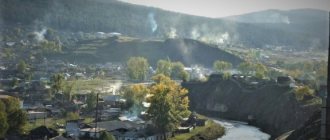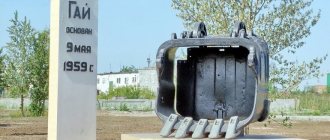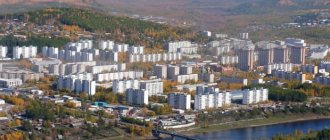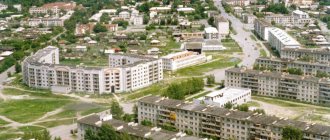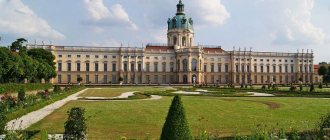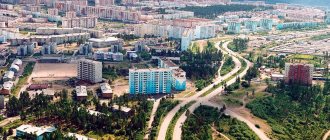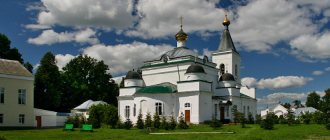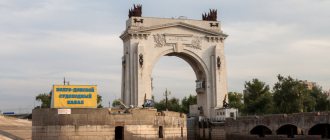Although the first samples of oil were produced on the Ukhta River at least three centuries ago, due to their remoteness and harsh climate, these places remained sparsely populated until the beginning of the 20th century. The “mountain oil” here rose to the surface on its own from the bottom of the river, but for a long time no one needed it. The decision to build a village, which later became the city of Ukhta, was made only in the late 1920s. The first decades of its history are closely connected with the history of the Gulag - at the dawn of the emergence of Soviet forced labor camps, this settlement became one of the key ones in their system. Everyone ended up here indiscriminately - peasants, former priests, prominent scientists, creative intelligentsia, and died here in the thousands - some from difficult working conditions, some from punitive executions. The foundation of the oil and gas industry of the Soviet Union was forged on their bones.
Today's Ukhta is one of the Russian centers for oil and gas production. Architecturally, this is a preserve of low-rise Stalinist Empire style. In ideological terms, it is a monument to the labor feat of Soviet prisoners and a symbol of the merciless era of the reign of the “Kremlin highlander.” In the memorial there is the center of the notorious Ukhtpechlag, and after that - Ukhtizhemlag, through the meat grinder of which the “beloved homeland” passed hundreds of thousands of destinies of its citizens.
Ukhta is the second largest city in the Komi Republic after Syktyvkar. This is the oil capital of the European part of Russia, the patrimony of Lukoil, Gazprom and Rosneft. The city is neat and clean, it is clear that there is a little less money in the local budget. Expensive SUVs with Moscow license plates flash here and there on the streets.
The city was built on the banks of the river of the same name. This name is Finno-Ugric: the hydronym uhtuo in the past designated channels and rivers (from which the name of the St. Petersburg Okhta River came). In the Komi language the city is called Ukva.
The main Ukhta attraction, visible from almost anywhere in the city, is the profile of Lenin’s grandfather, rising on the mountain closest to the city.
The height of this unusual structure is 33 meters. It was installed in 1970 in honor of the 100th anniversary of the birth of the “leader of the world proletariat.” In Soviet times, the monument was illuminated at night, but in the nineties, all the lights were successfully stolen. For almost thirty years the structure rusted and miraculously was not sawn into metal. A few years ago, local enthusiasts put it in order and are now raising money to restore the lighting.
It is believed that this is the largest “Ilyich’s head” in the world.
From the snowdrift closest to the “head” there is a beautiful view of Ukhta. The main part of the city fits well in one photo.
At the end of the 1930s, when the northern regions of the European part of the USSR were actively being developed, there was a project to move the republican capital from Syktyvkar to Ukhta. Due to the outbreak of the Great Patriotic War, this plan remained on paper, but it set the tone for the architectural appearance - the first stone buildings were designed with an eye to the possible capital status of the village.
Several blocks of good Stalinist buildings have been perfectly preserved to this day. These brick houses are not spoiled by advertising structures, split system boxes on the facades and satellite dishes. If you wish, you can easily create a beautiful open-air preserve of the Stalinist Empire style here - you just need to break out the soulless white plastic frames from all the windows and replace them with wooden ones with original glazing.
The old part of the city is very compact. You can easily walk around the perimeter in half an hour (photo source: ; author: Evgeniy Grokh).
The main square of Ukhta is Pervomaiskaya.
During Soviet times, churches across the country were turned into warehouses and clubs. Ukhta is probably the only city in which exactly the opposite happened. In 1948, a cultural center was built here. In the early 1990s, its building was transferred to the Russian Orthodox Church, and now it is the main temple of Ukhta.
All buildings in the center of Ukhta are mostly three- and four-story. This is wonderful: such houses look much more harmonious and pleasant than the seven- or more-story buildings in Moscow and St. Petersburg. In general, the low-rise Stalinist Empire style is the best thing that happened to architecture in Russia, from 1918 to the present day, including even constructivism.
Of course, wooden barracks from the 1930s have also been preserved in Ukhta. But who will surprise you with them?
Most of them are still residential. Sometimes it seems to me that they will outlive us all.
Artifacts on the walls are reminiscent of the communist past. It’s a pity, of course, that some Soviet traditions have faded into oblivion. For example, before each section of the street had a responsible person, and in case of any problems, everyone knew where to call and who to complain to.
Two central streets dividing the historical center of the city into several parts are Kosolapkina and Krems.
Ivan Ilyich Kosolapkin became the first Soviet master to drill for Ukhta oil in 1930. The wooden house that once belonged to him now houses the city museum of local lore. On the day of our arrival it was closed for renovations.
In 1939, Andrei Yakovlevich Krems developed a unique technology for oil production using the shaft method, and then stood at the origins of the oil and gas industry in the USSR. In Ukhta, his office, equipped from an ordinary two-room apartment, has been preserved. We will definitely look there today.
Eternal flame.
Park of culture and recreation.
Youth House.
If suddenly one of my St. Petersburg and Moscow friends forgot what winter usually looks like in Russia, then this is it.
About the history of Ukhta
During the times of Kievan Rus, these lands were owned by the Novgorod feudal republic. There was practically no population on them: only fur hunters. It was oil, and not oil, that for a long time was the most important strategic commodity of these places. People knew that they were rich in oil since the 15th century, but there was no need for it then. But fur was valued.
At the end of the 15th century, during the era of Ivan the Third, the territories in which present-day Ukhta is located were annexed by the Moscow Principality. In the 20s of the 16th century. The beginning of the Ukhta oil fields was laid. In 1745, with the approval of the Berg College, merchants founded the first “oil refinery” in Russian history in Ukhta.
It worked like this: oil was scooped up from the river surface and from coastal pits. Over the 20 years of the field’s existence, “as much as” 3.5 tons of oil were produced this way. In 1872-1873 The first well was drilled, from which 32 tons of oil were pumped out.
Nowadays, the old town of Ukhta is recognized as an object of historical and cultural heritage
At the beginning of the twentieth century, there were more wells. The Baltic German Alexander Georgievich Gansberg built an oil refinery (kerosene) plant and a power plant here. In 1918, the Soviet government nationalized the Ukhta oil fields.
The city of Ukhta arose on August 21, 1929, as a settlement of forced oil workers founded by the OGPU. There were 125 of them: political prisoners, criminals, dispossessed kulaks, as well as guards assigned to them, plus specialists - geologists and oil workers. At first the village was called Chibyu. New batches of prisoners were periodically sent there, for whom a 12-hour working day was established, without days off.
Oil production on an industrial scale was established in the fall of 1930. After this, roads and railways began to be built to the oil fields. In 1933, in the Ukhtpechlag of the village of Chibyu there were about 5 thousand prisoners and 206 civilian residents. The civilians lived in two-story wooden houses, the prisoners lived in barracks. In 1939, the village was renamed Ukhta.
In 1941, industrial gas production was established in this region for the first time in the history of our country. The leadership of the Komi ASSR planned at that time to move the capital of the republic from Syktyvkar to Ukhta. But with the outbreak of war, this project was postponed. Since 1943, Ukhta received official city status.
After the war, the oil and gas and processing industries, as well as the production of building materials in Ukhta began to develop at a very high pace. Pipelines were built to transport oil and gas.
Museum of Ukhta State Technical University
We didn’t get to the Ukhta Museum of Local Lore, but while walking around the city, we learned about the existence of another museum. Since 2009, the local technical university has opened its own historical exhibition, which, according to the students we met, is much more interesting than the city one.
The director of the university museum, Evgenia Anatolyevna Zelenskaya, was incredibly surprised by the delegation suddenly appearing on her doorstep in bright orange jackets, but still gave us a fascinating tour.
Back in the 16th century, fur hunters talked about Finno-Ugric tribes who lived on the banks of the Ukhta River and used the oil that rose from the river bottom for medicinal purposes. The first reliable written mention of Ukhta oil is found in the book of the Dutch traveler Nicholas Witsen “Northern and Eastern Tartaria,” published in 1692:
The Ukhta River is a tributary of the Pechora. On this river, a mile and a half from the portage, there is a shallow place where an oily substance is released, which floats on the water and is black oil.
In 1724, the first samples from the Ukhtinsky Oil Spring were delivered to St. Petersburg. Industrial development of the field began a quarter of a century later by merchant and ore explorer Fyodor Pryadunov, who in 1748 delivered the first convoy with 40 pounds of “Russian oil” to Moscow. The commercial plan failed, the fishery went bankrupt, and Fyodor Pryadunov himself ended his life in debt.
Until the end of the 19th century, oil was used mainly in medicine. A radical change occurred after the invention of kerosene lamps. Then the demand for oil increased sharply, and in 1868, in the same place where Fyodor Pryadunov’s field was once located, Russian entrepreneur Mikhail Sidorov began drilling the first oil well in the Russian Empire. In subsequent years, oil production in Ukhta actively developed, and even the revolution did not greatly affect this process.
The industrialization of the young Soviet state, announced in 1925, required centralized mining in various inaccessible places. There were no people willing to voluntarily go to work in the dense forests and swamps, so the government, in the spirit of the times, decided to “organize new forced labor camps in order to colonize these areas and exploit their natural resources through the use of prison labor.”
The issue with the labor force was resolved, and in 1929, at the confluence of the Chibyu River with Ukhta, the construction of one of the first Soviet camp centers began with the forces of the first detachment, which included political and criminal prisoners, former kulaks, civilians and security guards. It was named after the river - Chibyu.
In 1931, Ukhtpechlag (in full - Ukhta-Pechora forced labor camp) was formed on its basis. All lands from Mezen to the Urals and from Vychegda to the coast of the Arctic Ocean came under his control, in total more than a million square kilometers. Yakov Moroz, who had only two years of education behind him, was appointed head of the camp, but remained in his post until the reorganization of Ukhtpechlag in 1938. He didn’t need cars or horses (give more prisoners, and we’ll build a road even to the North Pole!), and he easily sent prisoners to the winter taiga without tents (they’ll warm themselves by the fire!) and without boilers for cooking food (they’ll do without hot!)…
By 1938, Ukhtpechlag had become completely ungovernable. Then three new formations were withdrawn from its composition: Ustvymlag with a center in Ust-Vym, engaged in timber extraction, Vorkutlag with a center in Vorkuta, engaged in coal mining, and Sevzheldorlag with a center in Knyazhpogost (now the city of Yemva), which was entrusted with the responsibility construction of the Pechora railway. Ukhtpechlag itself was transformed into Ukhtizhemlag, which concentrated on oil production. By the height of the Great Patriotic War, Ukhta oil and Vorkuta coal gained access to the main industrial centers of the country.
In 1939, Chibya was renamed Ukhta. In 1943, the village received city status.
Yakov Moroz was shot in 1940 for counter-revolutionary activities.
All exhibits presented in the museum are authentic. The portrait of Stalin, for example, was painted by one of the prisoners.
Conditions of detention in Ukhtpechlag were very cruel. I had to work 12-15 hours without days off. Many prisoners had neither warm clothes nor shoes, and the tents in which they lived did not have stoves. There was not enough food, and sometimes there were even cases of cannibalism.
In 1936, political prisoners of Ukhtpechlag organized the first strike in the history of the Gulag. They were waiting for an amnesty, or at least an improvement in living conditions, but in response a decision came from Moscow on mass executions.
Dry lines from the resolutions:
CHARGED with the fact that while serving his sentence in Ukht.Pech.ITL, together with a group of prisoners, he was engaged in systematic crime. [counter-revolutionary] agitation. He praised the tsarist system, discredited the bodies of Soviet power, and expressed sympathy for the fascists from the Troitsk-Zinoviev gang. SHOOT.
CHARGED that while serving his sentence in Ukht.Pech.ITL he carried out systematic crime. [counter-revolutionary] agitation, praising the tsarist system. He spread slander against Soviet power and expressed sympathy for the enemies of the people from the Troitsk-Zinoviev gang. SHOOT.
In total, several thousand people were shot; for the rest, the camp regime was tightened: production standards were increased by 25-30% and “columns” (a paramilitary form of labor organization) were introduced.
By the end of the 1930s, in Komi, through forced labor camps, 100% of oil and coal were extracted, 100% of electricity was generated, and 30% of timber was harvested.
Ukhta, along with all residential buildings, public buildings and industries, was built down to the last brick by prisoners. Remember, in the first part of my story I showed you a three-story Stalinist house with a beautiful arch? There, several years ago, during renovations in one of the apartments, under the floor, the following board was found (the original spelling was preserved):
June 5, 1951 Builders of the 14th OLP [individual camp point] carpenters With terms of 12 years without parole [loss of rights] 8 years without parole [defeat of rights] Dear Owners, Long live Nozdarov and for us
Here's another one:
Sharov worked here. He wishes the owners of this room a good life for many years. Of course, maybe someone will be offended by our work, but he will be wrong, because we did not come to build ships of our own free will. But we, even the unapproachables, do not look at us [inaudible], because we, too, were guardians [of the interests] of our homeland, our beloved homeland.
At the top it is written:
It has a lifespan of 7 years, 3 years. [defeat] in rights
Another message was found under the wallpaper in another house:
Builder Locust Petr Petrovich we are tried by decree for a period of 10 years the beginning of 1949 the end of 1959 we are tried for the construction of communism my crime is a penny prisoner the crime has not been proven by anyone just impudently judged required free labor born 1923 age 28 years torn from the family family went to beg
Scary and sad words. It is possible that these old boards and scraps of paper with the souls of prisoners poured onto them are all that remains of their lives...
Postcard.
Many of the prisoners of Ukhtpechlag and Ukhtizhemlag were rehabilitated after Stalin's death in 1953-1954. However, the operation of forced labor camps in Komi continued until the early 1960s.
According to declassified documents, at least one million one hundred thousand people passed through the millstones of Ukhtpechlag and Ukhtizhemlag alone. And these are only those whose cases are preserved in the archives.
One of the museum’s halls is dedicated to a unique method of oil production – the mine method.
This is how oil is produced in Yarega, a small village located 20 kilometers from Ukhta and formally being one of its administrative units.
I’ll tell you about the Yaregskoye oil field a little later, but for now just look at the next photo. This is oil-saturated sandstone.
Backstage (photo source: ; author: Evgeniy Grokh).
Ukhta was built at an accelerated pace. In 1929, on the site of the future city there was only a stunted swampy forest and a couple of rickety wooden buildings. By 1933, the mining technical school was commissioned, and by 1934, the theater. By the beginning of the Great Patriotic War, Ukhta was already a full-fledged city - with its own stadium, park, canteen-restaurant, department store and hotel.
In the university hall there is a model of the city of that time. Almost all the buildings then were wooden, and most of them have not survived to this day.
In the background with white columns is a school.
A large dark building with lit windows is a mountain technical school. The main administration of Ukhtpechlag was also located here.
The white building is the Ukhta dining room and restaurant.
Club-theater. Graduates of the best theater universities - actors, musicians and dancers from among the prisoners - performed on its stage. In 1948, the club-theater was dismantled, and in its place a stone cultural center appeared, which today has been turned into a temple (I talked about it a little higher).
Dynamo Stadium.
Ukhta Museum of History and Local Lore and its branches
An important historical building was chosen to house the exhibitions of this museum - one of the oldest built in Ukhta. This was the house of Ivan Ilyich Kosolapkin, a well-known personality in the city, an oil industrialist who made a significant contribution to the formation and development of this city.
The museum has been operating since 1981.
Its collections contain many wonderful exhibits on the history and ethnography of the region, as well as those that demonstrate the diversity and characteristics of the local nature. Its funds contain over 55.5 thousand exhibits of various kinds.
Thematic exhibitions that tell about the history of the city, about oil and gas production in its surroundings, about the culture and traditions of the Komi and other indigenous peoples of the North are held on an ongoing basis. A special place in the museum’s collection is occupied by those exhibits that reflect the history of the Ukhta-Pechora camp and the history of the Gulag in general.
Ukhta Museum of History and Local Lore
An important part of the institution is a special exhibition dedicated to the history of the development of the oil and gas industry in the region in the museum-apartment of a prominent geologist, honorary citizen of the city, Andrei Yakovlevich Krems. In this branch of the local history museum, operating since 1984, the furnishings of a scientist’s office are carefully preserved.
Other branches of the museum are the Museum of Geological Collection (Mira St., 5); Museum of the History of the Yarega Mines in the village of Yarega (Kosmonavtov St., 2); Museum of the History of the Vodny Village (in the Vodny Village House of Culture, Lenin St., 16)
Address: st. Mira, 5b. Office of A. Ya. Krems: on the street. Krems, 3.
Historical places and museums of Ukhta
Oil and Gas Museum
Address: Lenina Ave., 50 Phone: Website: https://ukhta-tr.gazprom.ru/press/complex_exhibition_halls/ Cost: free Opening hours: 08:00 – 16:15 Mon-Fri, Sat-Sun – closed How get there: by minibus No. 2, 5, 7 to the stop. "Kurchatova Street"
The museum complex has been operating since 2003. The exhibition halls are on two levels:
- the first demonstrates the history of the development and formation of the gas industry;
- the second serves as a venue for conferences, as well as temporary exhibitions and displays.
Visitors will learn about the development of city enterprises and the intricacies of the work of gas industry employees, and will be able to participate in an emulated flight on an MI-8 helicopter, both as a pilot and as a passenger.
Ukhta Museum of History and Local Lore
Address: st. Mira, 5b Phone: Website: https://uhtamuseum.ru/ Opening hours: 09:00 – 17:00 Tue-Sat, Sun-Mon – closed Cost: 100 rubles – adults, free – preferential categories of citizens, children under 16 years
The museum stores exhibits that came into its collection from archaeological expeditions: household items, finds describing the history of the Gulag camp, works of art and various documents about the development of the oil and gas industries.
Museum of Geological Collection
Address: st. Pushkina, 2 Phone: Website: https://uhtamuseum.ru/ Opening hours: 09:00 – 17:00 Tue-Sat, Sun-Mon – closed Cost: 100 rubles – adults, free – children under 16 years old, preferential categories citizens
The Geological Collection Museum houses various types of stone material (rocks, fossils, minerals), documents, photographs, a diorama of the ancient world, models of industrial installations and jewelry.
Museum of 20th Century Migrants
Address: st. Bushueva, 5b Opening hours: 10:00 – 15:00 Sat, Sun-Fri – closed
The museum is an old heated carriage, which contains a collection of antiques: household items of indigenous people and settlers, wartime finds, as well as belongings of political prisoners.
The exhibition was created by a resident of the city, V.V. Moor, in the museum, in addition to excursions, he is engaged in the restoration of exhibits.
Visitors are allowed to touch any objects.
Museum of Gazprom-transgaz Ukhta LLC
This complex of exhibition halls, which began in 2003, is dedicated to the history of the development of the gas industry in the Russian North. Their total area exceeds 1500 square meters.
Museum of Gazprom-transgaz Ukhta LLC
This exhibition space features 19 permanent exhibitions operating on two exhibition grounds. The exhibitions are designed using the most modern technologies. They very clearly tell about the long history of the industry. An interesting object of the exhibition is the diorama “Shine of the North”, depicting the moment of welding the first joint of pipes on the 1st Ukhta gas pipeline with the same name as the diorama.
There are excursions adapted for children - in particular, the quest game “Travel with Northern Gas”.
Moreover, here every visitor has the opportunity to take an imaginary flight in a Mi-8 helicopter over the gas pipeline route.
Address: Lenina Ave., 50. Since August 2022, a second exhibition has also been open, at the address: emb. Gazovikov, 10/1.
Museum of Liquidators of Technogenic Disasters
This museum opened in Ukhta on April 26, 2013, on the 27th anniversary of the Chernobyl nuclear power plant accident, on the initiative of a local public organization of Chernobyl liquidators. Its museum doors are always open to everyone, and primarily to schoolchildren.
Here the children are told about the essence of the Chernobyl disaster and about the work of fellow countrymen who took part in eliminating its consequences. Among the exhibits of the museum are the protective suits in which the liquidators worked, various dosimeters that measured the level of radiation, children's creative works on the theme of Chernobyl, photographs from the sites of those dramatic events and photographs of the liquidators of the accident themselves.
Museum of Liquidators of Technogenic Disasters
Educational films and videos about the accident at the Chernobyl nuclear power plant and the liquidation of the consequences of other man-made disasters in the USSR and Russia are shown.
After such an excursion, children can confidently talk about the Chernobyl accident in class and correctly answer any questions regarding this event.
Address: Kosmonavtov Ave., 19.
Cabinet-museum of Andrei Yakovlevich Krems
An ordinary courtyard in the center of Ukhta.
Here, in one of the standard apartments, there is the office-museum of Andrei Yakovlevich Krems.
He himself lived in a neighboring apartment, and came here to work. Since 1982, the office-museum has been considered a monument of republican significance. Personally, I found it interesting because the spirit of that era was very well preserved here.
The library of Andrei Yakovlevich Krems was considered almost the largest in Ukhta; in total, the office contained almost eight thousand printed publications: over two thousand books and a little less than six thousand newspapers and magazines. All of them are still in place.
Museum of 20th Century Migrants
A private museum, created by a local collector-enthusiast, head of the research club, Victor Moor. The museum was based on its collection of antiques, things and household items of the first half of the twentieth century.
This extraordinary exhibition is housed in a railway carriage built in 1902. Most of the exhibits presented in the museum came from immigrants to Ukhta from other regions of Russia - hence the name.
Museum of 20th Century Migrants
In addition to the unique feeling of traveling back in time, a visit to the Museum of 20th Century Migrants gives the visitor a deep understanding of how much human life has changed over these decades, how much easier and more comfortable it has become for everyone these days.
Address: st. Bushueva, 5b.
Ukhta Folk Drama Theater
This theater is the oldest in the Komi Republic. It was founded in 1934 on the initiative of prisoners of Ukhtpechlag. Moreover, from the very beginning he was not amateur, but, one might say, professional: there were enough prisoners - artists, musicians and representatives of other creative professions in these places.
The first artistic director and director of the theater was Joseph Girnyak, a political prisoner and theater actor from Ukraine, who was imprisoned in Ukhtpechlag from 1933 to 1937. The repertoire of the “theater behind barbed wire” is impressive: J. Bizet’s opera “Carmen”, performances by M. Gorky “At the Lower Depths”, A. Ostrovsky’s “Dowry”, etc.
Ukhta Folk Drama Theater
A new creative stage of the theater began in the 50s, when an excellent Central House of Culture was built in Ukhta.
All the best in the history of this theater is associated with Vera Mikhailovna Goi, who has been its permanent director since 1974. Therefore, it is often called the “Theater of Vera Goy”. Since 1997, the “Theater for Children” has been operating at the People's Drama Theater; The traditional festival "Fun" is held.
Address: Lenin Ave., 26 (House of Culture).
Monument to the Prometheans of the North
Driving along the Syktyvkar-Ukhta highway, at the entrance to the city you can see an extraordinary monument to an oil and gas industry worker. Surrounded by pipes, he lights a torch that brings warmth to the people. This monumental sculpture is dedicated to all participants in the development of local deposits and is called “Prometheans of the North”.
Monument to the Prometheans of the North
The monument was erected in November 2003. This is a bronze monument, 4 meters high, mounted on a high granite pedestal. The author of the monument was the famous sculpture from Syktyvkar A.I. Neverov. The worker’s sculpture fits well into the surrounding area and rightfully became one of the main symbols of the city of Ukhta.
Address: Lenin Ave., 50.
Monument to A.S. Pushkin
One of the main monuments in Ukhta is the monument to the great poet Alexander Sergeevich Pushkin, erected on Oktyabrskaya Square in 1999, on the eve of the 200th anniversary of the birth of the famous Russian writer.
Interestingly, this monument was a copy of another monument created by prisoners of Ukhtpechlag in 1937 to commemorate the 100th anniversary of Pushkin’s tragic death in a duel. It was made of plaster, cement, brick, and installed on a wooden pedestal. The sculpture did not have a metal frame, and it gradually collapsed over time.
Monument to A.S. Pushkin
The author of the original version, prisoner Nikolai Bruni, received a reward for his work from the camp authorities: several days of an unofficial meeting with his wife who came to see him. Just a few months after this, he was shot, having been convicted of “counter-revolutionary agitation” among prisoners. And the family was only informed many years later that he had died of pneumonia. In 1956, Bruni was posthumously rehabilitated.
The monument he created was very much loved in Ukhta and, despite its fragility, was maintained with repairs until the 1990s. And the bronze Pushkin became his copy.
Address: st. Pushkin.
Corruption and wage levels
I'll start with the kindergartens in order. There seems to be room in them. But there are at most 5-7 normal kindergartens where you can safely leave your “children” and be sure that they won’t be poisoned there or some chest of drawers will fall on their heads. One friend recently managed to place her child in one of these with the help of a couple of bribes totaling 30 thousand rubles. She is terribly happy. Now he can go to work, because he needs to save money for school!
The city is truly corrupt. You can’t get a single piece of paper without finance. Nobody wants to work in a free hospital. Recently, problems arose with the meniscus in the knee joint. It turned out that there is only one orthopedist per 100 thousand residents, and he is on vacation. Waited for him to return. They gave me a ticket for 16:00. Came at 15, went for an appointment at 21. Thank God, the doctor is conscientious - he overworks for a couple of hours every day. By the way, for the simplest operation to remove the ill-fated meniscus, I had to go to Syktyvkar, because in Ukhta with its famous “san town” such things are not done.
The average salary in the city, according to Internet data, is 38 thousand rubles. I don't know where these numbers come from. My mother is a teacher with 30 years of work experience and the maximum rank earns 20 thousand. My sister is a doctor, she studied for 8 years, has been working for four, and earns 18. To be honest, working as a salesperson in a store, you can earn a little more, and if you work two shifts, that's generally good. The actual salary level, not taking into account “bosses,” is 20 thousand rubles.
Memorial to fellow countrymen-participants of the Great Patriotic War
This monument to Ukhta front-line soldiers was erected in the city in 1980. Construction completed in 1984. The memorial is made in the form of a five-pointed star inscribed in a circle with a 14-meter diameter. From its rays rise 15-meter planes, symbolizing half-mast banners.
Memorial to fellow countrymen-participants of the Great Patriotic War
These planes are united by a ring, on the inner side of which a wreath is depicted, and on the outer side - five Orders of the Patriotic War. The eternal flame stands on a base made of Karelian granite. Granite steps lead to the pedestal. On the square in front of the main monument of the memorial there are eight granite pedestals with inscriptions.
Location: in the park on the bank of the Ukhta River, at the intersection of Mira and Oktyabrskaya streets.
Monument to graduates of the Ukhta school who died in the Great Patriotic War
The monument is located in the center of the main alley of the Children's Park, on a round platform, which was formerly called “Pioneer Glory Square”. The memorial consists of bas-relief images of pioneers and soldiers of the Soviet Army, as well as battle flags bowed in grief, painted on a concrete slab. Also attached to the slab are plaques with the names of fellow countrymen who died in the war.
Monument to graduates of the Ukhta school who died in the Great Patriotic War
Location: Children's park.
Churches and temples of Ukhta
Church of the New Martyrs and Confessors of Russia who shone forth in the land of Komi
Address: st. Zeryunova, 5A Phone: 8 (2167) 6-40-01, 8 (2167) 2-44-74 Website: https://sobory.ru/article/?object=16389
Included in the complex of the Church of the Intercession of the Blessed Virgin Mary. Local residents say that the church was built on the site of the first burials, which is considered holy.
Inside there is a myrrh-streaming icon of the New Martyrs, created by the best icon painters.
Church of St. Stephen the Great
Address: st. Oktyabrskaya, 8 Phone: , 8 (247) 4-09-78 Website: https://komihram.narod.ru/pr1/index.html
The church is located in the building of the city's former cultural center. The temple consists of a library, baptism and Sunday school.
Inside are icons painted by a local school teacher.
Church of the Intercession of the Blessed Virgin Mary
Address: Zeryunova Avenue Telephone: 8 (2147) 6-40-01 Website: https://komihram.narod.ru/pr6/index.html
The temple was built thanks to the efforts of local residents. It is a two-story building, where the abbot’s office, library and school are located on the first floor, and the prayer house is located on the second floor.
Inside is an iconostasis made by prisoners.
Included in the complex of the Cathedral of New Martyrs and Confessors of Russia.
Monument to the Pioneers of the North
On August 21, 1929, 125 members of the Ukhta geological exploration expedition of the OGPU, equipped in Arkhangelsk, founded the village of Chibyu - as a base settlement for exploration and production of oil and gas.
Monument to the Pioneers of the North
The memorial composition in honor of these first settlers consists of three reinforced concrete structures: a stele and two stylized drilling rigs 2.3 and 1.5 m high. On the stele there is a memorial plaque with the text: order for the Ukhta expedition No. 1 of August 21, 1929.
Location: on the left bank of the Ukhta River, opposite the buildings of the Ukhta Mechanical Plant.
Mount Vetlosyan with a huge profile of Lenin at the top
A significant landmark of Ukhta is the Vetlosyan Hill, which offers a wonderful view of the entire city. The name comes from the language of the Komi people: “Vetlosyan tui” means “hunting path”. During the GULAG, there was the village of Vetlosyan, next to a woodworking plant, and there was also a first-aid post, which was initially housed simply in army-style tents.
In 1970, on the occasion of the 100th anniversary of Lenin’s birth, an original art object was placed on Mount Vetlosyan, just opposite the railway station, which became one of the main symbols of the city of Ukhta. This is a giant profile of Lenin's head 33 meters high.
Initially, the profile was illuminated at night with 120 lamps, but in the 1990s this lighting disappeared, the metal structures rusted, and the memorial sign was in danger. Only in the 2010s was it restored and the lighting was returned to it.
Mount Vetlosyan with a huge profile of Lenin at the top
It is interesting that this profile, welded from metal pipes, was an “amateur activity” of local authorities - more precisely, the first secretary of the CPSU city committee of Ukhta in 1967 -1974. Nikolai Kochurin. On a trip to the sea, he saw such an object in Batumi, on a mountain, glowing. At home, for the 100th anniversary of the leader, I decided to install the same one, but significantly larger than the Georgian one in size. Realizing that approvals were fraught with long bureaucratic red tape, he organized the installation of a memorial sign without notifying senior management.
Using metal balconies and stairs you can climb to the height of the tenth floor and explore Ukhta not just from the mountain, but also from a bird's eye view.
LiveInternetLiveInternet
I want to tell you a little, but more to show the city in which I lived for 20 years, this is the city of Ukhta. I won’t tell you statistics and the like, you can read all this if you want to read it on Wikipedia. They brought me to this city in 1978, at the age of 4 years. It’s strange, but in 20 years Ukhta has never become my home. I don’t know what’s to blame for this - maybe the gray low sky, always overcast with clouds, maybe the cold northern climate, but reciprocity did not happen between us and this city. Ukhta has always been a stranger to me and I always knew that one day I would leave there forever, never to return. Just don’t think that I’m such a traitor, there’s not a lot of good things in Ukhta, the best thing about it is the people. Unique people. If you find yourself in this city, you yourself will understand that you will never remain hungry or cold there, you will always be warmed, fed, and watered - because the main wealth of this city is not oil, gas and other minerals, but people.
Every Ukhta resident knows this poem by Nikolai Volodarsky.
A WORD ABOUT UKHTA Don’t be afraid of the gray cloud, fly on a Yak, to TU! It is no coincidence that our city of Ukhta is called the pearl of the North. Here, once upon a time, in an abandoned land, winter did not spoil us. But white stone houses rose in the powder-covered taiga. We have built factories and fields, oil is running dutifully through the pipes. This is not fantasy, not speculation. Come visit and live!
And now I want to show you a selection of photographs.
Ukhta from a bird's eye view.
The building of the Ukhta airport.
Railway station. Waiting for the train.
Zh.D. Train station, exit to the city. To get to the city, it’s true that it’s still a long way to go.
Head, that’s what we call this monument. Well, no need to say whose head it is.))
Ukhta River, winter. View of the old city and oil refinery.
Lenin Avenue. Otherwise, in all small towns there is Lenin Avenue, but only in Ukhta there are still UFOs flying brazenly there.
And so the Ukhta River sometimes floods, about once every 20 years.
Old city. UkhtaBank building.
Monument to A.S. Pushkin, if anyone doesn’t recognize it. The history of the creation of this monument is interesting. It was made by prisoners from plaster and covered with bronze paint, but the monument soon collapsed, and this one was recreated from old sketches in stone.
Old city. I really love this part of the city. Stalin's houses, proper planning of the area.
Autumn.
And this is a new city. I worked in that yellow building for some time.
Komsomolskaya Square.
Palace of Culture, popularly called the House of Technology.
And in this supermarket I did an internship and even worked a little as a salesman.
Crossroads of Lenin-Cosmonauts.
Ukhta River, swimming pool on the right, where I learned to swim.
Entry into the city. The highway connecting Ukhta with the rest of the world))
Gas pipeline explosion. The phenomenon is frequent and somewhat commonplace.
Fountain at the Children's Park. The building in the center is the former Central House of Culture, now a church. So they put a cross in the lyre and here you have a temple - a madhouse, in a word.
The exit from the Park of Culture and Recreation, in common parlance - the Adult Park. If there is a children's one, then there must be an adult one too.
Fire Department.
Autumn. Always autumn or winter...
Another explosion. And it explodes all the time in almost the same place. This is G-z-z-z for a reason!
Ice drift on the Ukhta River.
3 days later, same place.
And this is a river flood.
I tried not to choose winter photos, because you can live in Ukhta in the summer!))
And we’ll also take a walk around Moscow one day, not the one that is shown on postcards, but the one that I know and love. I'll just get ready and take photos.
Eshmes Cave
This cave is a unique historical and archaeological monument. This is an ancient sanctuary of the indigenous peoples of the region, in which pagan rituals were performed.
Eshmes Cave
During the research and excavations, scientists found ancient artifacts in it that tell about the lifestyle, customs and way of life of the local population. Including spear tips, animal bones and teeth. As well as 35 different items made of silver and bronze: pendants and plates, 1 image of the Permian animal style, 2 silver coins - the first Iranian from the mid-10th century, the second from the German early 11th century. The most valuable finds were recognized as two idols, which were deposited in the local history museums of Ukhta and Syktyvkar.
Location: tributary of the river. White Ashmess.
Education
There were positive emotions about our university. The rector thinks highly of him. The university is quite popular in Russia and the largest specialized one in the north-west. To be honest, you won't learn much there. But student life is very exciting. Much attention is paid to students' leisure and sports. There is even a sanatorium where students can relax almost free of charge. But after graduating from the most prestigious specialty at the university, I was never able to find a job in the city. Therefore, now I am forced to travel to a village 130 km away in order to somehow improve my professional skills. And it's not that I didn't look well. The problem is that all the places are already occupied for 40 years in advance. Already now, every head of a production department knows where his son, grandson, nephew and son-in-law will work. Seriously, you shouldn’t hope to get a job at Transneft, Gazprom or Lukoil in this city without having connections. But most people are attracted to Ukhta by high salaries and living standards.
Nature reserves "Belaya Kedva", "Sedyuksky", "Chutinsky"
A number of nature reserves have been created in the Komi Republic. In the vicinity of the city of Ukhta there are also beautiful protected areas that are local natural attractions. They carefully preserve the beauty of nature in its original form. Of great interest are the rivers and forests, the unique landscape, and rare species of flora and fauna of the local region.
In the Belaya Kedva reserve



